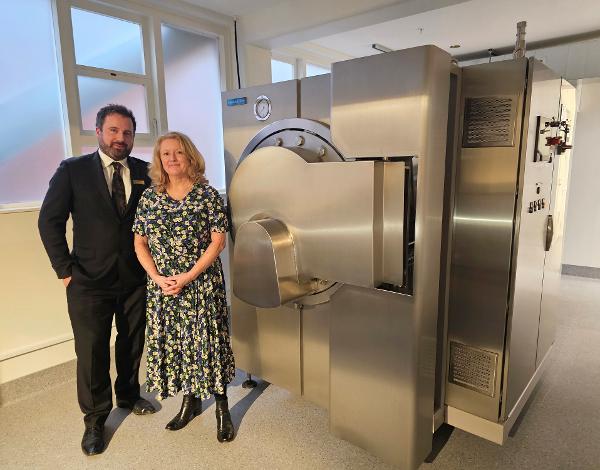Water Cremation Popular Choice Since Becoming Available For First Time in June
The country’s first water crematorium which opened in Christchurch in early June, is proving a popular option for Kiwis.
There have now been 55 water cremations at New Zealand’s first Water Crematorium, and co-director, Deborah Richards, says it is pleasing that people are taking up an option that is “gentler on people and the environment.”
“There are two things that stand out. Firstly, how keen people are to have a water cremation and secondly, once they make that commitment, how much they want to tell others about it,” she says.
Richards says Christchurch Water Crematorium (CWC) is seeing individuals pre-arrange a water cremation, then their partner is on board, and next it’s friends and relatives.
Andrew Bell, co-director and head of Bell, Lamb and Trotter, which is partnering with CWC at their premises in St Asaph Street, says with 80% of their clients choosing cremation over burial - around 75%-80% of those are choosing water cremation over flame cremation.
“The research we undertook prior to opening showed exactly the kinds of figures we are seeing,” he says. “Around the country approximately 80% of people opt for cremation as opposed to burial these days, and we are seeing the majority of those choosing water cremation over flame cremation. It is very satisfying to be able to provide an option that so many people clearly want,” he says, “particularly when it is an environmentally sustainable end-of-life choice.”
The amount of CO₂ saved from having water cremations instead of flame cremations, just in the last five months, is a little over 17 tonnes; about the same amount of CO₂ saved from going into the environment as recycling 6300 tons of material instead of putting it into landfill.
“With the ongoing climate crisis, changing the way we all do things so they become the norm with little if any extra effort to make that change, is absolutely the way to go,” says Richards.
Water Cremation, also called Alkaline Hydrolysis, uses water and an alkaline solution (potassium hydroxide) under pressure to mimic and speed up the natural process the body goes through when it is buried. Flame cremation requires the use of fossil fuels.
A body is placed inside the Resomator, usually in a biodegradable shroud (wool, silk), and the natural process is reduced to around 3-4 hours instead of decades. There is no carbon emitted in the resomation process itself.
Anything not of the body – such as pacemakers and implants remain behind, clean and intact, and can be recycled. The bones that remain after the process is complete can be returned to the family as bones or white ash, it is their choice. There is slightly more ash resulting from a water cremation than a flame cremation.
Interest is coming from across the county as Christchurch is currently the only place where water cremation is available.
Bell, Lamb and Trotter was the first funeral director in the country to introduce embalming in 1896 and flame cremation became available in 1909.
Open Day details:
Sun 23rd Nov, 1-4pm. Christchurch Water Crematorium, Bell Lamb Trotter 318 St Asaph St
https://watercremation.co.nz/ https://belllambtrotter.co.nz/water/
Frequently asked questions (FAQs):
What is Water Cremation?
Water Cremation is an alternative for flame cremation. It has been used by funeral homes all over the world since the early 21st century.
Instead of using flame generated by fossil fuels, water cremation uses water and an alkaline solution (potassium hydroxide) under pressure to mimic and speed up the natural process the body goes through when it is buried.
Using a Resomator, which is about the size of small car, a body is placed inside, usually in a biodegradable shroud (wool, silk), the natural process is reduced to around 3-4 hours instead of decades.
There is no carbon emitted in the Resomation process itself.
Anything not of the body – such as pacemakers and implants remain behind, clean and intact, and can be recycled. The bones that remain after the process is complete can be returned to the family as bones or white ash, it is their choice. There is slightly more ash resulting from a water cremation than a flame cremation.
Is there a casket at a water cremation?
Only biodegradable material may be placed in the Resomator. Silk or wool is often used as a shroud for the loved one and this too is broken down in the resomation process. A casket can be used prior to the resomation itself.
What temperature is the cremation?
A water cremation uses water at a temperature of 150 degrees Celsius (to create steam). That compares with temperatures between 850 and 1100 degrees Celsius for flame cremation.
Where else in the world is water cremation available?
United States: Aquamation is legal in many states, with the number offering it steadily increasing.
Canada: Saskatchewan was the first province to approve the process in 2012.
United Kingdom: Water cremation became legal in the UK in 2023.
Ireland: The first European country to offer water cremation, becoming available in 2023.
South Africa: Aquamation was introduced in South Africa in 2019.
Australia: Aquamation is available in New South Wales.
New Zealand: Christchurch Water Crematorium opened June 2025 at Bell Lamb and Trotter
Additional:
Bell, Lamb and Trotter was established in Christchurch in 1872, the first funeral directors to bring embalming to New Zealand. Flame cremation was introduced to New Zealand in 1909.
Archbishop Desmond Tutu (died in 2021) chose water cremation due to its environmental benefits.
There were 37,647 deaths in New Zealand to end of March 2025 (stats.govt.nz). Around 70% of people are cremated (2022 figs).
To see a render/animation of the process, please click below: (not for broadcast or publishing) https://drive.google.com/file/d/1O9R6RLvCi5p7iuPRbGQq_fSDQV2yN7t3/view?usp=drive_link

